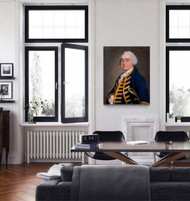Thomas Gainsborough (1727-1788)
Published by Elizabeth Goodman on 19th Jul 2019
Thomas Gainsborough is an English painter that gained his fame in the field of portraits. His career echoes the opportunities that were becoming apparent to a painter in this time period, as self-portraits became more and more popular. Gainsborough first established his practice in provincial cities, and by maintaining his close connections to London through his personal contacts, he regularly had his works displayed in exhibition venues that regularly brought him projects that quickly reflected his style- which served as a model for future generations of painters- notably John Constable and Joseph Mallord William Turner.
Gainsborough had a difficult life, as his father was a failed clothier who declared bankruptcy in 1733, and Gainsborough was lucky enough to have the skills to be declared an artistic prodigy and was sent to London to apprentice with Hubert Francois Gravelot, and later with Francis Haymen. Gainsborough adopted the skills that the French had taught him, most notably rococo style of Gravelot, and his master's practice of drawing small- scale dolls. When he married in 1746, he married to a woman who made an annual income of 200 Pounds- which gave Gainsborough the independence he needed to focus on his art. When his father died in 1748, Gainsborough found himself in need of patronage, so he built a practice in his home of Sudbury, England.
Thomas received 75 guineas for one of his works of art in 1788, and wrote with satisfaction about his experience in order to find a wider clientele base, and his recent success allowed him to raise his prices to 20 guineas for a head portrait, 40 for a half-length portrait, and 80 for full length portraits, which allowed him to make a considerable fortune for his gift, however he quickly began to hate it- and sent a letter to his friend and composer about how he would rather paint landscapes while smoking cigarettes. Despite this, he remained the preferred painter of every royal family in London from 1774 onwards, even though his relationships with his rivals remained strong, he constantly had the patronage of other artists, aristocrats and politicians that guaranteed his success and lasting prosperity that has been preserved in many museums to this day.
Thomas Gainsborough is famous for his style of painting, and his attention to light and how it is displayed on the canvas, and his attention to shadow and light effects is often seen in his work, and often he would paint by candlelight with long brushes to achieve a distance appearance from the canvas.
Even upon Thomas Gainsborough's death in 1788, his close friends and pupils always commented on his style of painting in many annual lectures to students and members of his chosen establishment, the Royal Academy- acknowledging that the odd scratches and marks that were seen from a view up close all fell into place with a sort of uncanny magic at certain distances which allowed viewers to see the parts that Thomas Gainsborough worked with falling into place when you viewed the painting from a particular perspective.
View Thomas Gainsborough Gallery

